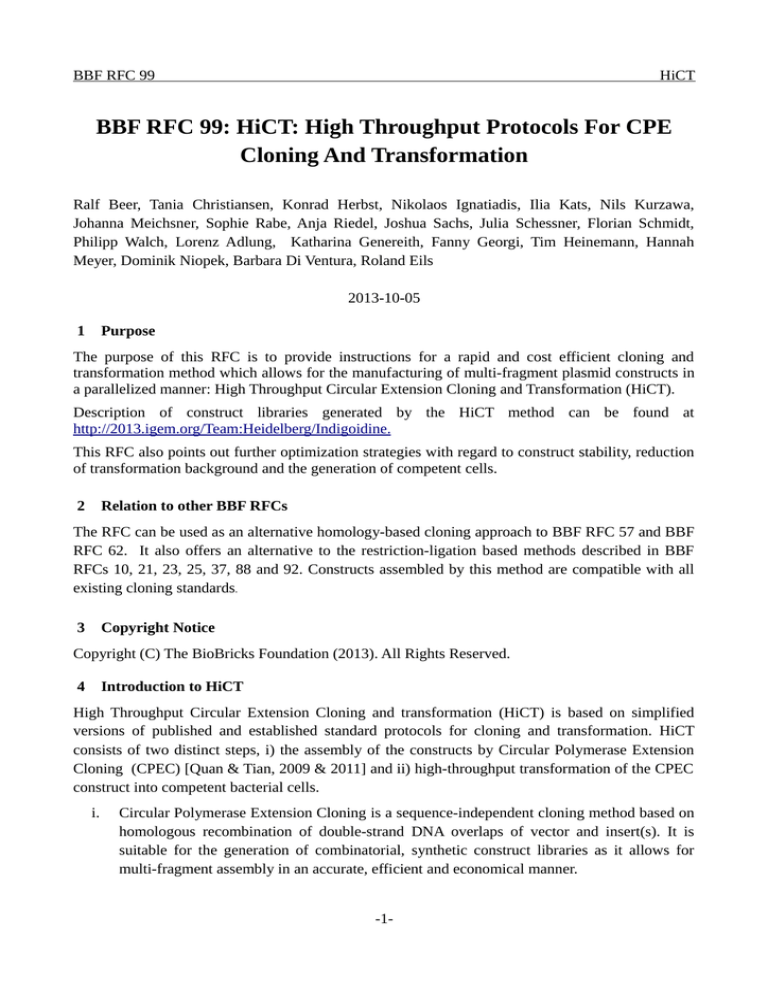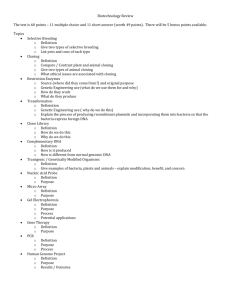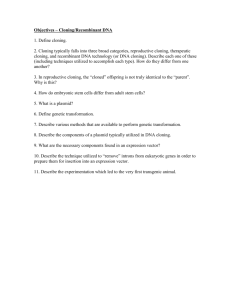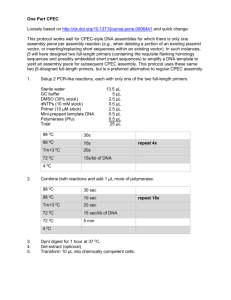
BBF RFC 99
HiCT
BBF RFC 99: HiCT: High Throughput Protocols For CPE
Cloning And Transformation
Ralf Beer, Tania Christiansen, Konrad Herbst, Nikolaos Ignatiadis, Ilia Kats, Nils Kurzawa,
Johanna Meichsner, Sophie Rabe, Anja Riedel, Joshua Sachs, Julia Schessner, Florian Schmidt,
Philipp Walch, Lorenz Adlung, Katharina Genereith, Fanny Georgi, Tim Heinemann, Hannah
Meyer, Dominik Niopek, Barbara Di Ventura, Roland Eils
2013-10-05
1
Purpose
The purpose of this RFC is to provide instructions for a rapid and cost efficient cloning and
transformation method which allows for the manufacturing of multi-fragment plasmid constructs in
a parallelized manner: High Throughput Circular Extension Cloning and Transformation (HiCT).
Description of construct libraries generated by the HiCT method can be found at
http://2013.igem.org/Team:Heidelberg/Indigoidine.
This RFC also points out further optimization strategies with regard to construct stability, reduction
of transformation background and the generation of competent cells.
2
Relation to other BBF RFCs
The RFC can be used as an alternative homology-based cloning approach to BBF RFC 57 and BBF
RFC 62. It also offers an alternative to the restriction-ligation based methods described in BBF
RFCs 10, 21, 23, 25, 37, 88 and 92. Constructs assembled by this method are compatible with all
existing cloning standards.
3
Copyright Notice
Copyright (C) The BioBricks Foundation (2013). All Rights Reserved.
4
Introduction to HiCT
High Throughput Circular Extension Cloning and transformation (HiCT) is based on simplified
versions of published and established standard protocols for cloning and transformation. HiCT
consists of two distinct steps, i) the assembly of the constructs by Circular Polymerase Extension
Cloning (CPEC) [Quan & Tian, 2009 & 2011] and ii) high-throughput transformation of the CPEC
construct into competent bacterial cells.
i.
Circular Polymerase Extension Cloning is a sequence-independent cloning method based on
homologous recombination of double-strand DNA overlaps of vector and insert(s). It is
suitable for the generation of combinatorial, synthetic construct libraries as it allows for
multi-fragment assembly in an accurate, efficient and economical manner.
-1-
BBF RFC 99
HiCT
CPEC relies on a simple polymerase extension of the DNA fragments to be assembled.
Crucial to this concept is the design of vector and insert fragments which MUST share
overlapping regions at the ends (Figure 1.1). In a single reaction set-up, insert DNA
fragments and linear vector are heat denaturized and allowed to anneal at elevated
temperature, resulting in specific hybridized insert-vector constructs (Figure 1.2).
Subsequently, the single-strand hybrid constructs are extended under standard
PCR-elongation conditions (compare to 5.1) which yield completely assembled,
double-stranded circular constructs (Figure 1.3) ready for transformation into competent
cells. The single strands nicks introduced on each strand due to the unidirectional nature of
the polymerase chain reaction will be removed by endogenous ligases upon transformation
into Escherichia coli [Quan & Tian, 2009 & 2011].
ii.
High-throughput transformation of the CPEC constructs is realized by adaptations of
standard heat-shock protocols with chemical competent Escherichia coli cells. Parallel
processing and easy handling of several constructs at once is facilitated by reduced reaction
volumes allowing for experiment conduction in multi-well plates
By HiCT, construction of combinatorial libraries can be achieved in less than a day. Transformation
of CPEC assemblies with up to four fragments was shown to yield comparable results as obtained
with regular transformation and ligation techniques. HiCT is independent of natural or
manufactured restriction sites within the DNA sequences of interest and allows for easy
introduction of rather small functional DNA units like promoters or ribosome binding sites.
Additionally, it is possible to insert restriction sites via the CPEC primers (compare Table 1), thus it
is compatible with most known cloning methods.
HiCT is optimized for small reaction volumes and requires only small amounts of DNA due to
omission of preparatory steps such as a priori generation of complementary single-strands as is
required for other homologous recombination assembly methods [BBF RFC 62]. Usage of standard
PCR reagents renders HiCT a cost efficient alternative to more expensive methods relying on
multiple enzymes, e.g. conventional restriction digest approaches [BBF RFC 10, 21, 23, 25, 37, 88
and 92] or Gibson Assembly [BBF RFC 57]. However, the polymerase chosen for the extension
reaction MUST not have strand displacement activity (Phusion® High-Fidelity PCR Master Mix is
recommended). The accuracy of the construct assembly is achieved by annealing temperatures of
53°C which ascertain high specificity of the insert-vector fragment assembly [Quan & Tian, 2009
& 2011].
-2-
BBF RFC 99
5
HiCT
HiCT protocol
The well-disposed user SHOULD abide by the procedures presented in this section in order to yield
similar results as we did.
Figure 1: Circular polymerase extension cloning: a sequence-independent, homologous recombination
based cloning approach. (1) Insert and backbone fragments sharing overlapping regions at their ends are
transferred into a single reaction set-up in molecular ratios determined by equation 1 (compare to 5.1.4). (2)
The insert/backbone reaction mixture is heat-denaturized and subsequently cooled down to 53°C to allow for
annealing of the complementary overlaps. (3) By polymerase chain reaction, the single strand hybrid-regions
are filled up to double strands yielding circular, double-stranded molecules with nicks at overlapping regions.
(4) Plasmids resulting from CPEC can be used directly for transformation.
Figure adapted from [Quan & Tian, 2009]
5.1 Using chain polymerase extension for plasmid assembly
The user SHOULD consider the following for plasmid assembly by Chain Polymerase Extension:
A) Primers used for fragment amplification MUST yield homologous overlaps with similar
melting temperatures and overlaps MUST be between 20 to 25 bp in size. For
multi-fragment assembly, no more than two fragments MUST contain the same single
overlap. The users MAY use the primer sequences depicted below (Table 1), which allow for
rapid cloning of coding sequences of interest and standard BioBrick backbones like
pSB1C3, pSB3K3 with BBa_J04450 as insert.
-3-
BBF RFC 99
HiCT
Table 1: Overview of primers that MAY be utilized for backbone linearization. The reverse primers (rv) differ in
the ribosomal binding sites they introduce: BBa_J04450_B0034-RBS_ATG_rv contains the ribosomal binding site
B0034, BBa_J04450_B0029-RBS_ATG_rv introduces the ribosomal binding site B0029 which is weaker than B0034.
Note that the 5' overhangs (underlined) of the reverse primers (rv) already include the start codon (depicted in bold) of
the coding sequence to be introduced as insert into the corresponding backbone. The resulting expression cassette will
be driven by the Plac promoter (R0010).
Primer
Primer sequence(5’ --> 3’)
Cutting site
BBa_J04450_stem_loop_fw
TAATGA GCTAGC TAATAACGCTGATAGTGCTAGTG
NheI
BBa_J04450_B0034-RBS_ATG_rv CAT GGTACC TTTCTCCTCTTT CTCTAGTATGTGTG
KpnI
BBa_J04450_B0029-RBS_ATG_rv CAT GGATCC GGTTTCCTGTGTGAA
CTCTAGTATGTGTGAAATTGTTATCC
NheI
The user MAY use the reverse complement of the underlined sequence and partial backbone
sequence for its own primer design.
B) The total amount of DNA per reaction MUST be between 50 to 200 ng per reaction.
C) Molar fragment ratios used SHOULD be 3:1 for insert:backbone and SHOULD be 1:1 for
insert:insert.
D) Conversion from mass concentration of fragments to molar concentration MAY be done
using the following formula:
c⋅106
=c
n⋅660 M
where c refers to the measured oligonucleotide concentration [ng/µl], n refers to the
fragment length in base pairs and cM refers to the concentration [nM].
E) Final reaction volume MUST be adjusted by the user to obtain sufficient amount for
subsequent procedures. We suggest 6 µl of total reaction volume of which 5 µl SHOULD be
used for one transformation and the remaining 1 µl MAY be used as quality check on
agarose gel with.
The user MUST use the following modified version of the CPEC protocol proposed by Quan &
Tian [2009]:
1. The user MUST prepare half of the desired reaction volume composed of the
fragment/backbone and water solutions as described in considerations A to E.
2. The user MUST fill up the other half of the reaction mixture with polymerase master mix
(Phusion® High-Fidelity PCR Master Mix with HF Buffer, NEB #M0531S/L).
-4-
BBF RFC 99
HiCT
3. The reaction MUST be incubated in a thermocycler at the following conditions:
1)
Initial denaturation at 98°C for 30 s
2)
Denaturation step at 98°C for 5 s.
Annealing step at 53°C for 15 s
1x
5x
Elongation/filling up step at 72°C for 20 s/kb of longest
fragment.
3)
Final extension at 72°C for 5 min.
1x
4)
(Optional: Hold at 12°C )
forever
4. The yielded assembly mixture SHOULD be used directly for transformation as described in
5.2.
5.2 High Throughput Transformation
High Throughput Transformation is a modified version of standard heat-shock protocols which
reduces processing time and allows for easy parallelization. It can be used for constructs prepared
by CPE as well as for constructs cloned by any other method. Each transformation SHOULD be
carried out in a volume of 200 µl, for easy handling 8-tube PCR strips or 96 PCR multi-well plates
are recommended.
The user MUST obey to the following instructions in order to transform desired constructs into
Escherichia coli:
1. Competent cells MUST be thawed on ice when stored at -80 °C
2. DNA of constructs of interest or 5 µl of CPEC mixture from step 5.1 MUST be transferred
into reaction wells (note: The DNA amount to be used depends on transformation efficiency
of the competent cells). For re-transforming purified plasmids, DNA amounts of 5 to 10 ng
for a single plasmid transformation and 25 ng of each plasmid for co-transformation are
recommended.
3. 30 µl of competent cells MUST be added to each reaction well. DNA MUST be
homogenously distributed within each reaction well. The competent cells-DNA mixture
MUST be kept on ice for 10 min.
4. The heat-shock MUST be carried out in thermocycler which has an operation temperature of
42 °C. The heat-shock MUST have a duration of exactly 1 min. Immediately following
heat-shock, cell-DNA mixture MUST be placed on ice for two or three min.
5. The user MUST add 170 µl of LB medium to each reaction mixture in order to recover cells
for 45 min at 37 °C. If ampicillin is used for selection the cells MAY be applied to
corresponding selection plates directly.
6. The user MUST spread 70 to 100 µl of the recovered cell suspension onto selection plates
containing the corresponding antibiotics which are then cultivated under standard conditions
(8 to 24 hours at 37 °C).
-5-
BBF RFC 99
6
HiCT
Possible improvements of HiCT
The user MAY follow suggestions 6.1-6.3 in order to improve transformation efficiency of the
HiCT protocol.
6.1 Decreasing vector background by methylation sensitive digestion
The user MAY decrease backbone template background of the transformation by adding an
additional digestion step with a methylation sensitive endonuclease immediately after backbone
fragment amplification by PCR. Specifically, for the methylation sensitive endonuclease DpnI
(NEB #R0176S/L) full activity in Phusion® High-Fidelity PCR Master Mix with HF Buffer (NEB
#M0531S/L) or similar master mixes has been reported (NEB Catalog, Appendix, Activity of
Restriction Enzymes in PCR Mixex, p.328). Thus, the user MAY apply the restriction enzyme
directly into the reaction mix after PCR amplification of corresponding fragments. The user MUST
heat-inactivate the DpnI digest before adding DpnI digested fragment to the CPEC assembly
reaction (note: according to the manufacturer, DpnI digestions are efficient when using 0.5 to 1 µl
of enzyme per 50 µl PCR reaction. The digest mix SHOULD be incubated for one to several hours
at 37 °C, followed by heat inactivation at 80 °C for 20 min).
6.2 Ligation step for improving construct stability
Because Circular Polymerase Elongation leads to circular DNA molecules with DNA backbone
nicks at fragment borders the user MAY consider to improve the stability of the desired constructs
by closing nicks with an additional ligation step before transformation.
6.3 Competent cells
The user MAY use freshly prepared competent cells if transformation efficiency is low for
competent cells kept at -80 °C. The user MAY employ the following protocol to generate chemical
competent cells:
These materials MUST be used:
▪ 100 mM CaCl2 (aq)
▪ Glycerol
▪ 20 ml Escherichia coli overnight culture (LB medium, at 37°C)
1. 10 to 15 ml of overnight culture MUST be transferred into 200 ml LB medium
2. The cells MUST be grown at 37°C until an OD of 0.40 to 0.55 is reached (3-5 hours). After
preparation, CaCl2 solution SHOULD be put on ice and the freezing/storage buffer (6 ml
CaCl2 with 10% glycerol) SHOULD be prepared and MAY be sterile filtered.
3. The bacterial cultures in log phase SHOULD be aliquoted into four falcon tubes (50 ml
volume) and MUST be centrifuged for 30 min at 3750 rpm and 4°C. The subsequent steps
MUST be carried out on ice.
-6-
BBF RFC 99
HiCT
4. The user MUST discard the supernatant and MUST resuspend the bacteria in 10 ml of CaCl2
solution per two falcons (in order to pool 2 falcons) and MUST add up to 50 ml per falcon
with CaCl2 solution. The user SHOULD have obtained two falcons which MUST be chilled
on ice for 30 min.
5. The falcons MUST be centrifuged for 20 min at 3750 rpm at 4°C afterwards.
6. The user MUST discard the supernatant, MUST resuspend the bacteria pellets of both
falcons in 2.5 ml of storage buffer and MUST add another 2.5 ml of storage buffer. The cell
suspension SHOULD be mixed well but MUST not be vortexed.
7. The user MAY than aliquot the competent cells to appropriate volumes and vials prechilled
on ice and put directly into a -80°C freezer or MAY use the cells directly for transformation.
7
Author's contact information
•
•
•
•
•
•
•
•
•
•
•
•
•
•
•
•
•
•
•
•
•
Ralf Beer: beer@stud.uni-heidelberg.de
Tania Christiansen: tania.christiansen@web.de
Konrad Herbst: k.herbst@stud.uni-heidelberg.de
Nikolaus Ignatiadis: Nikos.Ignatiadis01@gmail.com
Ilia Kats: kats@stud.uni-heidelberg.de
Nils Kurzawa: nilskurzawa@yahoo.de
Johanna Meichsner: Meichsner@stud.uni-heidelberg.de
Sophie Rabe: a.rabe@stud.uni-heidelberg.de
Anja Riedel: anja.riedel@gmx.net
Joshua Sachs: Joshua.Sachs@gmx.de
Julia Schessner: schessner@stud.uni-heidelberg.de
Florian Schmidt: Schmidt.florian391@gmail.com
Philipp Walch: Philipp.walch@web.de
Lorenz Adlung: l.adlung@dkfz.de
Katharina Genreith: k.genreith@dkfz.de
Fanny Georgi: fanny_georgi@hotmail.com
Tim Heinemann: t.heinemann@dkfz.de
Hannah Meyer: hannah.v.meyer@googlemail.com
Dominik Niopek: d.niopek@dkfz.de
Barbara Di Ventura: barbara.diventura@bioquant.uni-heidelberg.de
Roland Eils: r.eils@dkfz.de
-7-
BBF RFC 99
HiCT
8 References
Ellis, T., Adie, T., & Baldwin, G. S. (2011). DNA assembly for synthetic biology: from parts to
pathways and beyond. Integrative biology : quantitative biosciences from nano to macro, 3(2),
109–18. doi:10.1039/c0ib00070a
Gibson, D. G., Young, L., Chuang, R., Venter, J. C., Iii, C. A. H., Smith, H. O., & America, N.
(2009). Enzymatic assembly of DNA molecules up to several hundred kilobases. Nature, 6(5),
12–16. doi:10.1038/NMETH.1318
Horton, R. M., Hunt, H. D., Ho, S. N., Pullen, J. K., & Pease, L. R. (1989). Engineering hybrid
genes without the use of restriction enzymes : gene splicing by overlap extension sequences ;
frequency of errors ; exon ; intron ; mosaic fusion protein ; mouse histocompatibility genes ),
77, 61–68.
New England Biolabs Inc. 2013-14, Catalog & Technical Reference
Quan, J., & Tian, J. (2009). Circular polymerase extension cloning of complex gene libraries and
pathways. PloS one, 4(7), e6441. doi:10.1371/journal.pone.0006441
Quan, J., & Tian, J. (2011). Circular polymerase extension cloning for high-throughput cloning of
complex and combinatorial DNA libraries. Nature protocols, 6(2), 242–51.
doi:10.1038/nprot.2010.181
-8-





